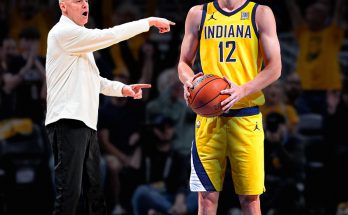“This kid reminds me so much of Trent Williams — he’s got that rare combination of elite strength and athleticism,” Jason Kelce said about Josh Simmons.
Jason Kelce is not someone who gives out high praise lightly. As one of the most respected voices in professional football, especially among offensive linemen, Kelce has spent years battling in the trenches, recognizing what separates the average from the extraordinary. So when he speaks glowingly about a young player, people listen. That’s precisely what happened when Kelce spoke about Josh Simmons, comparing him to one of the most dominant offensive linemen of this generation, Trent Williams.
“This kid reminds me so much of Trent Williams — he’s got that rare combination of elite strength and athleticism,” Kelce said. The words weren’t offhanded or made to spark headlines. They came from a place of genuine respect and football acumen. In Kelce’s view, Simmons isn’t just another promising player. He sees something foundational, something transformational. He sees the type of potential that could redefine a franchise’s offensive line.
To understand why this comparison carries so much weight, you have to understand who Trent Williams is. Widely regarded as one of the best left tackles in NFL history, Williams combines size, agility, and power in a way that has rarely been seen before. He’s a nine-time Pro Bowler, an All-Pro selection, and someone who changes the entire identity of an offensive line simply by being present. Williams isn’t just big; he’s explosive. He can move laterally like a tight end, deliver punishing blocks in the run game, and handle elite edge rushers with the kind of calm footwork and hand placement that makes defensive coordinators question their schemes. That’s the mold Kelce is placing Simmons into.
Josh Simmons hasn’t been in the spotlight nearly as long as Williams, but the buzz around him is getting louder. Scouts have been watching his progression closely. At every step of his development, Simmons has demonstrated a rare blend of size and movement that makes coaches and analysts alike take notice. He’s not just big; he’s fluid. He doesn’t just finish blocks; he dominates them. And he does it all with a presence and demeanor that reminds veterans like Kelce of greatness.
When watching Simmons on tape, the similarities to Williams start to emerge. He fires out of his stance with urgency, engaging defenders with violence and control. He rarely loses ground, even against power rushers. And his second-level mobility — the ability to reach linebackers or pull and lead a run play across the formation — is something you just don’t see often from linemen his size. Simmons doesn’t lumber. He glides. It’s the kind of trait that can’t be coached; it has to be innate.
Jason Kelce’s praise also reflects how high-level offensive linemen view the game. For them, it’s not just about who’s biggest or strongest. It’s about technique, footwork, intelligence, and consistency. When Kelce watches Simmons, he sees a young man who isn’t just physically imposing, but who processes the game at a high level. That’s a key part of what made Trent Williams so successful. He wasn’t just more athletic than everyone else — he understood angles, timing, and leverage. Simmons is showing signs of that same mental mastery.
And it’s not just Kelce who sees it. Across the league, from coaches to scouts to former players turned analysts, there’s a building consensus that Simmons could be one of the next dominant forces on the offensive line. His performance in camps, games, and practices continues to turn heads. His commitment to refining his technique, improving his hand placement, and studying film reflects the mindset of someone not satisfied with just being good. He wants to be great. And that hunger — that drive — is what separates the elite from the rest.
There’s also something to be said about how Simmons carries himself off the field. Like Williams, he is known for his quiet confidence, his work ethic, and his focus. He’s not chasing clout on social media or engaging in distractions. He’s locked in. He’s someone teammates respect not just for what he does during games, but for how he prepares in the weight room, in the film room, and during practice. Veterans appreciate that. Coaches appreciate that. It creates a ripple effect that can elevate an entire offensive unit.
For younger players, especially those entering the league with high expectations, comparisons to legends can be a double-edged sword. On the one hand, it signals belief in their potential. On the other, it creates a level of pressure that not everyone can handle. But Simmons, by all accounts, seems built for it. He embraces the challenge. He’s not intimidated by the names being thrown around. If anything, it fuels him.
And this is where Kelce’s comment takes on deeper meaning. He’s not just saying Simmons is talented. He’s saying Simmons might be generational. That matters. Kelce has gone head-to-head with countless defensive linemen. He knows what it takes to hold your ground when a 300-pound pass rusher is charging at you with bad intentions. He knows what it means to play through pain, to protect your quarterback when the blitz is coming, to execute the perfect pull block when the game is on the line. So when he looks at Simmons and sees shades of Trent Williams, it means something.
Of course, potential isn’t the same as production. Simmons still has a long road ahead of him. The NFL is filled with players who showed flashes early but never reached their ceiling. What separates those who ascend from those who plateau often comes down to discipline, coaching, health, and resilience. Simmons will need to stay grounded, continue refining his craft, and be ready to adjust to the inevitable adversity that comes in a pro football career. But with someone like Kelce already vouching for his trajectory, the outlook is promising.
For fans of offensive line play — a subset of football lovers who appreciate the subtleties of pancake blocks and protection calls — Simmons represents something exciting. He’s a reminder that the position is evolving. Today’s elite linemen aren’t just brawlers. They’re athletes. They’re technicians. They’re thinkers. Simmons embodies that evolution. He’s the kind of player who could anchor an offensive line for a decade, much like Williams has done.
And for young linemen coming up through high school and college ranks, Simmons is quickly becoming a model to emulate. Watch how he moves his feet. Study how he keeps his pad level low. Learn how he uses his hands with precision. That’s how you survive in today’s game. That’s how you excel. Simmons might still be writing the early chapters of his story, but the foundation is there. And when someone like Kelce puts his stamp of approval on a young lineman, it means the foundation isn’t just solid — it’s built to last.
So while Josh Simmons continues to grow, learn, and take the next steps in his football journey, the football world will be watching closely. Not just to see if he lives up to the comparison, but to see if he surpasses it. After all, being compared to Trent Williams is one of the highest compliments a lineman can receive. But the true goal — the true mission — is to carve out a legacy that’s all his own.
And if Simmons stays the course, keeps putting in the work, and leans on the traits that already have people like Jason Kelce buzzing, he just might get there. The league is always looking for the next dominant force on the line. Josh Simmons might be exactly that.



